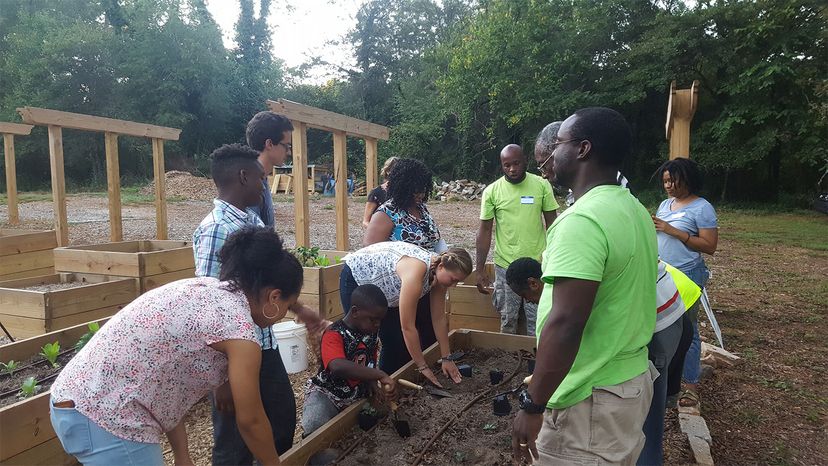“
 “Volunteers work in Atlanta’s first community food forest, the Urban Food Forest at Browns Mill Road. The Conservation Fund
“Volunteers work in Atlanta’s first community food forest, the Urban Food Forest at Browns Mill Road. The Conservation Fund
A stunning 11.8 percent of American households — about 40 million people — experienced food insecurity (lack of financial resources to buy sufficient food) at least some of the time in 2017, according to the United States Department of Agriculture (USDA). Enter community food forests, which are helping to ease a problem in a way that captures the very best of social and environmental-consciousness all at once.
Food forests are a far cry from community gardens, as they’re not rows and rows of standard plant beds. Instead, they’re designed to mimic natural forests using food-bearing trees, roots, greens, vines, plants and the like, while making the most of the space available. As a result, food forests are picturesque, calming, gathering areas for community members looking to enjoy a piece of nature, while picking whatever produce they need for free.
"The concept behind food forests is that natural forests are highly productive in their own right, and totally self-sustainable over extremely long timeframes. So, by following the functional patterns that exist in a natural forest and adapting them to the conditions of light and space that each species need in order to be productive, we can create very low maintenance production zones that are essentially harvest systems," explains Giuseppe Tallarico, an agronomist specializing in permaculture, food security and environmental management systems, who is also the founder and manager of the World Permaculture Association. "Each element in the system is selected and placed in relationship to other elements so that they are as much as possible, mutually self-supporting in terms of nutrient and space-sharing," he adds.
Imitating Nature’s Patterns
By mimicking natural patterns in nature as much as possible, the hope is that every species’ needs (whether humans, animals or plants) will be met in a sustainable way. Although there’s some wiggle room for layout, a typical food forest is designed with a canopy of large nut and fruit trees, followed by a lower tree layer of "dwarf" fruit trees.
Next is a shrub layer composed of those that produce berries and currants, followed by a layer of herbs and then by root crops, such as potatoes and carrots.
The soil surface is planted with ground cover-specific crops, and finally a layer of vertical climbers and vines (like grapes or kiwis) is incorporated.
Most of these spaces aren’t even all that huge. In fact, when it opens, Atlanta’s Urban Food Forest at Browns Mill will be the city’s first and the largest in the U.S. at 7.1 acres (2.8 hectares). Even better, food forests are often planned to make use of previously wasted space. The Dr. George Washington Carver Edible Park in Asheville, North Carolina took over an area once occupied by a trash heap. And the Glendale Community Garden in West Akron, Ohio was created on a vacant lot, an all-too-common eyesore in cities across the country.
It Takes a Village to Feed the Hungry
It’s not unusual for community churches, schools and governments to establish food forests of whatever size they can manage with the help of civic organizations and volunteers. One food forest per area isn’t going to totally eradicate the hunger issue, however. In fact, the Urban Food Forest at Browns Mill in Atlanta is one prong of a city-wide effort to make healthy food accessible to 85 percent of city residents by the year 2022.
"The area is a USDA classified food desert, so benefitting the immediate neighborhood is the primary goal," says Mike McCord, a food forest ranger with Trees Atlanta in an email. "A group of neighbors manages the community garden and herb area, while Trees Atlanta and other partners manage the orchard and forested sections of the land."
If the food forest is free and open to the public, how do they keep visitors from taking more than their fair share, or selling the harvest for profit? "We ask that people only harvest food when managers are present, to prevent improper harvesting techniques," McCord explains. "For the most part, our managers are only present at the volunteer days, so those are the only times for harvesting."
Although the movement is now gaining steam, food forests took a minute to get off the ground. The Asheville forest was the first of its kind in the U.S., although Tallarico notes that human agro-ecology systems have been used in many other traditional societies such as those in Java, Bali, Central and South America, and New Guinea over the years. A couple more popped up here and there after Asheville’s launch in 1997, but it wasn’t until after Seattle’s Beacon Hill Food Forest garnered much publicity in 2012 that these projects really started to gain traction. As of 2018, there are more than 70 food forests established across the U.S., and thousands more around the world.
Now That’s Cool
Want to learn how to design the ideal food forest? Enroll in a permaculture design class to learn the ins and outs of food forest creation. And in case the term is unfamiliar to you, permaculture is "a holistic, living-in-harmony-with-nature worldview, as well as technical approach for how to do so," according to a definition in Modern Farmer (there are many variations of this definition that you’ll find if you Google the word.)


